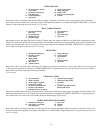
22
HelPful HinTs foR PRessuRe CooKinG
Your favorite recipes may be adjusted for cooking in the canner by following the general directions in this book for the particular type
of food being cooked. Decrease the length of cooking time by two thirds, since pressure cooking is much faster than ordinary cooking
methods. Because there is little evaporation from the canner, the amount of liquid should be decreased. Add about 2 cups more liquid
than desired in the finished product. There must always be water or some other liquid in the bottom of the canner to form the necessary
steam.
Use the cooking rack when it is desirable to cook foods out of the cooking liquid. When foods are pressure cooked out of the liquid,
flavors will not intermingle. Therefore, it is possible to cook several foods at once, as long as they have similar cooking times. If it is
desirable to blend flavors, do not use the cooking rack.
When the body of your canner is heated, the metal expands. Therefore, it may be difficult to close cover on heated body. When this
happens, allow canner to cool slightly.
Foods are quickly cooked in the canner. Therefore, to prevent overcooking it is important to accurately time the cooking period.
If your cooked food has more liquid than you desire, simmer to evaporate excess liquid.
When pressure cooking at high altitudes, cooking time should be increased 5% for every 1000 feet above the first 2000 feet. Following
this rule, the time would be increased as follows:
3000. . . . . . . 5% 5000 . . . . . . 15% 7000 . . . . . . .25%
4000 . . . . . 10% 6000 . . . . . . 20% 8000 . . . . . . .30%
If you have questions on recipes or timetables write to: Test Kitchen, National Presto Industries, Inc., 3925 North Hastings Way, Eau
Claire, Wisconsin 54703-3703, phone 1-800-368-2194. You may also contact us at our website www.gopresto.com. Inquiries will be
answered promptly by letter, phone, or email.
PRessuRe CooKinG MeaT
Savory, tender meat is easily prepared in the canner. The most important step is to sear meat to a crispy brown on all sides to seal in
natural juices.
Meat recipes are cooked at 15 pounds pressure.
Cooking time depends on the amount and distribution of fat and bone, toughness, size and thickness of cut, grade and cut of meat, and
the manner in which the meat fits into the canner. Rolled roasts require a longer cooking time per pound than roasts with bone. Short,
chunky roasts take longer to cook than long, flat roasts. Because of the difference in thickness, a small, thick roast requires a longer
cooking time per pound than a heavier, flat roast.
The following recipes were written for fresh or completely thawed meats. To cook frozen meats, thaw half an hour or more, just enough
so that the meat will have contact with the bottom of the canner and sear crispy brown. Then increase the cooking times given in the
recipes. Frozen beef, veal, and lamb should be cooked 25 minutes per pound—frozen pork, 30 minutes per pound.
After pressure cooking time is completed, serving size pieces of meat may be quick cooled. However, when cooking a roast cut of meat,
pressure must drop of its own accord to be sure that pressure is reduced both within the roast and the canner.
After cooking, if more crispness is desired, place meat under a broiler 1 to 3 minutes. If gravy is desired, stir 2 to 4 tablespoons of flour
or cornstarch into ½ cup cold water. Heat liquid in canner and stir in flour mixture. Heat to boiling, stir constantly for 1 minute or until
thickened. Season with salt and pepper.
DO NOT FILL CANNER OVER TWO-THIRDS FULL!
These recipes are intended for pressure cooking and should not be canned.
COOKING RECIPES: MEAT
POT ROAST
9 lbs. beef shoulder or rump roast 2 onions, sliced
Salt and pepper 4 cups water
¼ cup cooking oil
Heat canner, add oil, and brown meat well on all sides. Place cooking rack and roast in canner. Season roast with salt, pepper, and
onion; add water. Close cover securely. Place pressure regulator on vent pipe and COOK 45 MINUTES at 15 pounds pressure. Let
pressure drop of its own accord. 15-18 servings.


















